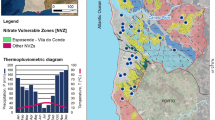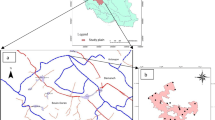Abstract
In Italy the protection of groundwater against the deterioration of both quality and quantity is one of the top priorities of water policy and this is reflected in the substantial regulatory developments. The assessment of groundwater vulnerability to contamination is required to be conducted in accordance with environmental regulations, the most significant at the national level being Legislative Decrees 152/2006 and 30/2009, which concern a variety of environmental issues. One common form of pollution of both surface and groundwater that has been afflicting industrialised countries for decades, is nitrate contamination. This is also a major issue in Sardinia where, by means of the Water Protection Plan (PTA) it has been possible to delineate potential Nitrate Vulnerable Zones (ZVN) at the regional scale. Pursuant to the Regional Government resolution No. 1/12 of 18/01/2005, the Bonifica di Arborea, where intensive agriculture and dairy farming form the mainstays of the local economy, has been designated as a ZVN. Numerical flow and transport models have been employed to simulate groundwater conditions for assessing current nitrate contamination of the shallow aquifer. Using the calibrated and validated numerical model, it was also possible to simulate future scenarios, essential for drawing up plans for effective interventions.
Access provided by Autonomous University of Puebla. Download conference paper PDF
Similar content being viewed by others
Keywords
1 Description of the Study Area and of Environmental Problems Focusing on Agricultural and Livestock Farming Activities
The study area, the Bonifica di Arborea (Fig. 42.1) (folios 528 and 538 IGM Cartography 1:50,000), extends over roughly 70 Km2 and forms part of the coastal flood plain overlooking the Gulf of Oristano in western Sardinia. The area lies within the administrative boundaries of the Municipality of Arborea and in the northernmost part of the Campidano plain. It is situated in a natural depression bounded by the S’Ena Arrubia lagoon northwards, the inlet occupied by the Marceddi and San Giovanni lagoons southwards, the state highway 131 to the NE and the edge of the Arborea plain to the SE. The coastline extends for some 15 km and features extensive sand beaches, vast wetlands (S’Ena Arrubia and Corru S’lttiri) and a dune field stabilised through afforestation in the past with Pinus Pinea (Piano Urbanistico Comunale Arborea 2008).
Once the reference frame had been completed in terms of regulations and the physical environmental, the different types of groundwater hazard sources were identified, focusing on agricultural and livestock farming activities (ARPAS 2009; RAS 2005). Agricultural practices that rely on the use of fertilizers and cattle manure for enhancing soil productivity, accompanied by the intensive use of groundwater resources, have made this area particularly vulnerable to nitrate contamination. In fact, due to overexploitation, the groundwater, which naturally contains little nitrogen, has been affected by infiltration from the surface of enormous quantities of nitrogen which are stored in the unsaturated layers of the soil and are progressively leached into the groundwater itself (Uras et al. 2005; Padovani and Trevisan 2002).
2 Application of Numerical Flow and Transport Models for Simulating Current Scenarios
The domain of the shallow aquifer for developing the numerical model was determined after conceptualization of the aquifer based on the analysis of the cartography, stratigraphy, agronomy, climate, precipitation time series and the pertinent literature (Di Molfetta and Sethi 2012). The water level and nitrate concentrations data recorded at the stations in the monitoring network set up in 2007 were of particular importance for constructing the conceptual model. Using this database it was possible to apply the basic physical-environmental models to gain a deeper understanding of the current status of groundwater contamination in the study area and then predict future trends.
The numerical model for simulating groundwater flow allowed us to conduct a more detailed analysis of the influence that the different conditions exert on the hydrogeological regime. The flow model was chosen on the basis of the conceptual model developed and is a finite difference model that employs the MODFLOW computer code (MODular three dimensional finite difference groundwater FLOW model). Groundwater flow was modelled and the model calibrated for steady state conditions and subsequently for transient state conditions. The model was validated by simulating flow variations in 2001 and 2007 (during which period agriculture and livestock farming reached a peak). To check that the modelling results were consistent with the real situation we used the data recorded during the 2007 field measurements. The simulation results can be considered satisfactory as they confirm the trend of the flow lines in an E-W direction for the groundwater, that flows into the S’Ena Arrubia lagoon northwards, into the Marceddi lagoon southwards and into the inlets at Pauli Pirastu and Corru S’Ittiri eastwards (Fig. 42.2).
Reclamation work in Arborea, carried out between 1919 and 1935 in what was originally swamps and marshland, produced profound and radical alterations, destroying the original landforms and sedimentation environment. The operations that drastically transformed the area consisted chiefly in filling in and draining the lacustrine and palustrine depressions, installing large pumping systems, the Luri pumping station situated to the South, having a major impact.
Bearing this in mind, we conducted flow simulations, again using a numerical model with MODFLOW computer code, to determine the actual functionality of this pumping station. The results indicated a vortex at the pumping station, that corresponds to the actual situation whereby the system continuously withdraws water, ensuring the constant recirculation with sea water. In fact, we performed one simulation assuming a sudden breakdown of the pumping system, the result being that those areas from which the water was pumped off become flooded. This reflects the original swampy conditions that emerged from examination of the maps of the area prior to installation of the pumping system, as can be observed in Fig. 42.3. (Cagliari State Archives cartography 1907, IGM scale 1:100,000 Folio 217 “Oristano”—first edition).
A finite difference numerical model with MT3D (Modular Three Dimensional Transport Model) computer code was used to estimate contaminant transport. This model uses the results obtained from the validated MODFLOW model as input. In fact, to solve the contaminant transport equation requires the actual linear flow rate to be known. Nitrate contamination of the groundwater originates from constant, non-point sources, as the nitrogen compounds used as fertilizers are uniformly distributed throughout the farmland within the Bonifica di Arborea area. During the period 2001–2007 fertilizers were grossly overused, owing to the intensive agricultural and livestock farming. It is estimated that the nitrogen compounds, the source of contamination, spread over farmland during that time amount to some 500 kg ha−1yr−1. This figure has been calculated on the basis of the number of livestock raised and the nitrogen requirements of the different types of crops grown in the area. Contaminant diffusion has been evaluated starting from the year 2001, for which a nitrate concentrations database, created by ARPAS (Sardinian Regional Environment Protection Agency) is available, from data collected through their monitoring network, over the following 5 years which represent the situation in 2007 for which data are available from another 2007 database.
With regard to the contaminant transport model, the results obtained were as to be expected. In fact, the simulated values of contaminant transport in the aquifer coincide with those actually measured in 2007.
As can be observed, in 2007 the transport simulations show peaks of nitrate concentrations of as much as 200–400 mg/l, well above the prescribed limits. In most of the reclaimed area however simulated concentrations average around 50–100 mg/l except for the town of Arborea itself and the beach where the values are lowest (15–50 mg/l), as clearly no crops are cultivated in these areas. It was not possible to determine nitrates transport at the Luri pumping station due to the continuous pumping and recirculation of the water (Fig. 42.4).
3 Application of the Numerical Transport Models for Predicting Future Scenarios and Conclusions
The Nitrates Directive was implemented in the Bonifica di Arborea area from 2006 onwards, hence one assumes that from that time on, nitrogen fertilization has been reduced by half (permissible amount prescribed under the Directive around 250 kg ha−1yr−1). Using the MT3D model it has been possible to simulate contaminant transport over a 10 year period from 2007 to 2017. Maintaining the same amount of fertilizer, over the 10 year period nitrate concentrations in the groundwater would diminish substantially. In fact, the peaks that reached values of 400 mg/l in 2007, would decrease to around 90 mg/l, still above the permissible limits but substantially lower. It follows that adopting an appropriate action plan, the entire contaminated area could be remediated and an excellent equilibrium created between agricultural/livestock farming and the ecosystem as a whole, striking a gradual balance between the need for development and the need to protect environmental resources.
Modelling is undoubtedly a more accurate and reliable method for determining groundwater flow and contaminant transport than those based on interpolation. Unlike other available methods, in model construction the actual geological and hydrogeological characteristics of the aquifer are taken into account, but above all the problem can be addressed by solving the equations governing the phenomenon. Thus in engineering terms modelling represents a valid tool for monitoring groundwater resources and for developing future scenarios.
References
Agenzia Regionale per la Protezione dell’Ambiente della Sardegna ARPAS (2009) Piano di monitoraggio e controllo della ZVN di Arborea—Relazione at tivita 2007–2009
Comune di Arborea (2008) Piano Urbanistico Comunale, Assetto Ambienta le- Relazione agronomica, settembre 2008
Di Molfetta A, Sethi R (2012) Ingegneria degli acquiferi. Springer, New York
Padovani L, Trevisan M (2002) I nitrati di origine agricola nelle acque sotterranee (Un indice parametrico per l’individuazione di aree vulnerabili). Pitagora Editrice, Bologna
Regione Autonoma della Sardegna (2005) Programma d’azione per la Zona Vulnerabile da Nitrati di Origine Agricola di Arborea—Ex. Delib. G.R. del 18 gennaio 2005, n. 1/2
Uras G, Mulas MG, Sodde M, Testa M (2005) Vulnerability to nitrates of agricultural origin in Sardinia. The Arborea area—aquifer vulnerability and risk, 2nd international workshop 4th congress on the protection and management of groundwater, Reggia di Colorno Parma, 21-22-23 settembre 2005
Author information
Authors and Affiliations
Corresponding author
Editor information
Editors and Affiliations
Rights and permissions
Copyright information
© 2015 Springer International Publishing Switzerland
About this paper
Cite this paper
Galiano, I.C., Mannai, C., Matzeu, A., Uras, G. (2015). Numerical Flow and Transport Models for Simulating Current and Predicted Nitrate Contamination in Groundwater in the Bonifica Di Arborea Area (W. Sardinia, Italy). In: Lollino, G., Arattano, M., Rinaldi, M., Giustolisi, O., Marechal, JC., Grant, G. (eds) Engineering Geology for Society and Territory - Volume 3. Springer, Cham. https://doi.org/10.1007/978-3-319-09054-2_42
Download citation
DOI: https://doi.org/10.1007/978-3-319-09054-2_42
Published:
Publisher Name: Springer, Cham
Print ISBN: 978-3-319-09053-5
Online ISBN: 978-3-319-09054-2
eBook Packages: Earth and Environmental ScienceEarth and Environmental Science (R0)








